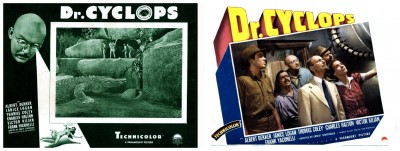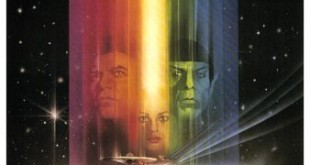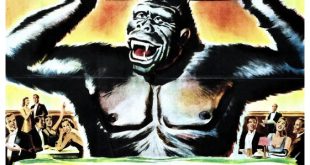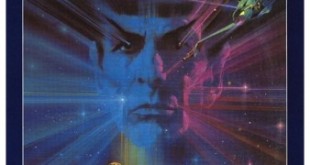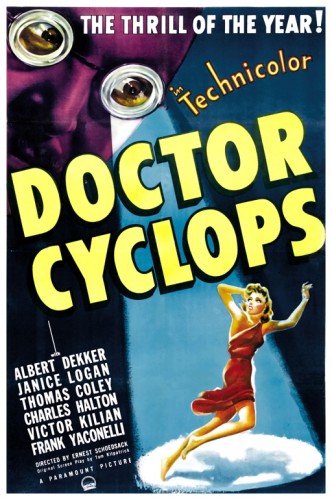 SYNOPSIS:
SYNOPSIS:
“After a former student discovers a rich deposit of radium in a South American rain forest, the brilliant but arrogant Dr. Alexander Thorkel sets up a laboratory there and begins experimenting on miniaturization of animals. When the pupil questions the scientists ethics, he callously murders him. Faced with failing eyesight, the mad doctor enlists three other scientists to help identify the roadblock that has delayed completion of his project. After a long and arduous journey by pack mule through the Andes, they arrive at the laboratory and quickly identify Thorkel’s problem. Steve Baker, a miner and fourth member of their party, realizes the value of the radium and is reluctant to leave as are the scientists, who feel slighted by Thorkel’s dismissive attitude and their concern about his now growing megalomania and paranoia. Feeling threatened by their curiosity concerning the true nature of his work, he miniaturizes them along with a native servant as they become his de facto guinea pigs. Although their situation appears grave, their one hope lies in Thorkel’s Achilles heel, his failing eyesight.” (courtesy IMDB)
REVIEW:
One of the minor side-effects of the Second World War was to help cause, some years after it ended, a boom in science fiction but, during the actual wars years, science fiction reached its lowest ebb and remained there until the end of the decade. While real-life mad scientists were working in various countries on weapons far beyond the imagination of Hollywood scriptwriters, the cinema’s collection of mad scientists were still busy with innocuous goals such as turning men into apes or vice-versa, making people invisible or simply shrinking them in size. If only the situation could have been reversed, the world might have remained a much less disturbing place.
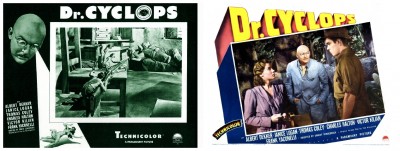 In Doctor Cyclops (1940), biologists Mary Robinson (Janice Logan) and Doctor Bullfinch (Charles Halton) are summoned by Doctor Alexander Thorkel (Albert Dekker) to his remote laboratory in the Peruvian jungle. They are accompanied by mineralogist Bill Stockton (Thomas Coley), a friend of Mary’s and a last minute substitute for another scientist, and Steve Baker (Victor Killian), who wants to make sure his hired mules are well cared for (and suspects Thorkel may have discovered a rich mine). When they arrive, Thorkel asks the scientists to describe a specimen in his microscope, since his eyesight is too poor for him to do so himself. Bill identifies iron crystal contamination, much to Thorkel’s satisfaction. Then, to their astonishment, Thorkel thanks them for their services and asks them to leave.
In Doctor Cyclops (1940), biologists Mary Robinson (Janice Logan) and Doctor Bullfinch (Charles Halton) are summoned by Doctor Alexander Thorkel (Albert Dekker) to his remote laboratory in the Peruvian jungle. They are accompanied by mineralogist Bill Stockton (Thomas Coley), a friend of Mary’s and a last minute substitute for another scientist, and Steve Baker (Victor Killian), who wants to make sure his hired mules are well cared for (and suspects Thorkel may have discovered a rich mine). When they arrive, Thorkel asks the scientists to describe a specimen in his microscope, since his eyesight is too poor for him to do so himself. Bill identifies iron crystal contamination, much to Thorkel’s satisfaction. Then, to their astonishment, Thorkel thanks them for their services and asks them to leave.
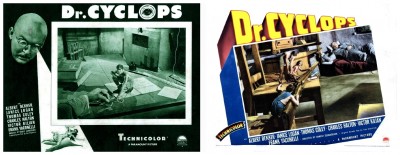 Insulted that they have traveled thousands of miles for nothing, they set up camp in Thorkel’s stockade, insisting that he tell them more about his research. Snooping around, Steve discovers the area is rich with pitchblende, an ore of uranium and radium. When he finds them looking around his laboratory, Thorkel becomes angry but, since he is outnumbered, reveals he is shrinking living creatures, among them a horse, using radiation piped from a radium deposit down a deep shaft. He invites them and his assistant Pedro (Frank Yaconelli) to examine his device, then locks them inside his radiation chamber. With the information that Bill has provided, he is able to correct the flaw that has killed his prior specimens. When his victims awaken, they find they have shrunk to only twelve inches tall.
Insulted that they have traveled thousands of miles for nothing, they set up camp in Thorkel’s stockade, insisting that he tell them more about his research. Snooping around, Steve discovers the area is rich with pitchblende, an ore of uranium and radium. When he finds them looking around his laboratory, Thorkel becomes angry but, since he is outnumbered, reveals he is shrinking living creatures, among them a horse, using radiation piped from a radium deposit down a deep shaft. He invites them and his assistant Pedro (Frank Yaconelli) to examine his device, then locks them inside his radiation chamber. With the information that Bill has provided, he is able to correct the flaw that has killed his prior specimens. When his victims awaken, they find they have shrunk to only twelve inches tall.
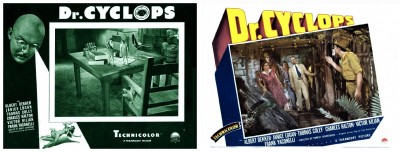 They flee from Thorkel only to encounter Thorkel’s cat Satanus, from whom they are saved by Pedro’s dog Tipo, who seems bewildered by his master now being smaller than him. Bullfinch is eventually coaxed into speaking with Thorkel, but the latter is not interested in negotiating, merely in measuring Bullfinch. When he discovers that Bullfinch is growing, he realises that the effect is only temporary. He murders Bullfinch in cold blood and sets out to hunt the others down so that they cannot go to the authorities. The four survivors hack their way through gigantic jungle foliage and do battle with the wildlife. They attempt to launch Pedro’s small boat, but are attacked by a caiman, a kind of alligator.
They flee from Thorkel only to encounter Thorkel’s cat Satanus, from whom they are saved by Pedro’s dog Tipo, who seems bewildered by his master now being smaller than him. Bullfinch is eventually coaxed into speaking with Thorkel, but the latter is not interested in negotiating, merely in measuring Bullfinch. When he discovers that Bullfinch is growing, he realises that the effect is only temporary. He murders Bullfinch in cold blood and sets out to hunt the others down so that they cannot go to the authorities. The four survivors hack their way through gigantic jungle foliage and do battle with the wildlife. They attempt to launch Pedro’s small boat, but are attacked by a caiman, a kind of alligator.
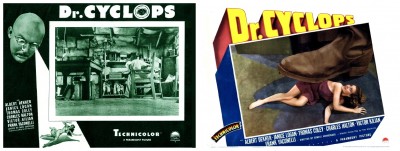 When Thorkel locates them using Pedro’s dog, Pedro leads Thorkel away from the others and is shot dead. The fugitives hide in one of Thorkel’s specimen cases and are brought back undetected to his lab. While Thorkel goes outside to adjust a machine, Bill, Steve and Mary prepare to kill him with his own shotgun when he lies down on his bed. However, he instead falls asleep at his desk. They hide his spare glasses, then Steve steals the pair Thorkel put on his desk, managing to smash one lens before Thorkel awakes. Thorkel chases the shrunken trio to the mineshaft and precariously hangs by a rope when the plank he was lying on breaks. Steve cuts the rope, causing Thorkel to plunge to his death. Suddenly jumping to several months later, Bill, Steve and Mary return to civilisation, restored to their original size, Bill and Mary reveal they are in love, and they all lived happily ever after.
When Thorkel locates them using Pedro’s dog, Pedro leads Thorkel away from the others and is shot dead. The fugitives hide in one of Thorkel’s specimen cases and are brought back undetected to his lab. While Thorkel goes outside to adjust a machine, Bill, Steve and Mary prepare to kill him with his own shotgun when he lies down on his bed. However, he instead falls asleep at his desk. They hide his spare glasses, then Steve steals the pair Thorkel put on his desk, managing to smash one lens before Thorkel awakes. Thorkel chases the shrunken trio to the mineshaft and precariously hangs by a rope when the plank he was lying on breaks. Steve cuts the rope, causing Thorkel to plunge to his death. Suddenly jumping to several months later, Bill, Steve and Mary return to civilisation, restored to their original size, Bill and Mary reveal they are in love, and they all lived happily ever after.
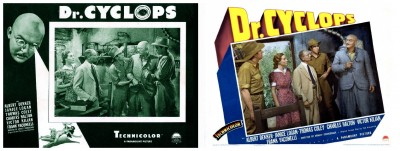 Though really a straightforward melodrama – the pseudo-science is just an excuse to tell a fundamentally Gothic tale – the film does contain two significant (if unintentional) hints of the approaching apocalypse: One is that Thorkel draws his power for his device from a ‘radium mine’ near his laboratory; the other is that, with his shaven head and thick spectacles, he resembles what was to become the caricature of the ‘beastly Jap’ by the end of the war. It was obviously just a strange coincidence since, when the the film was made in 1939, there was no real anti-Japanese feelings in the United States and therefore no reason for the filmmakers to have their villain appear Japanese.
Though really a straightforward melodrama – the pseudo-science is just an excuse to tell a fundamentally Gothic tale – the film does contain two significant (if unintentional) hints of the approaching apocalypse: One is that Thorkel draws his power for his device from a ‘radium mine’ near his laboratory; the other is that, with his shaven head and thick spectacles, he resembles what was to become the caricature of the ‘beastly Jap’ by the end of the war. It was obviously just a strange coincidence since, when the the film was made in 1939, there was no real anti-Japanese feelings in the United States and therefore no reason for the filmmakers to have their villain appear Japanese.
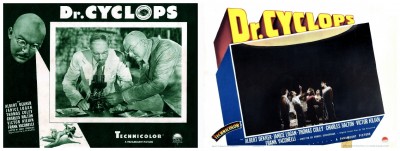 Directed by one of the makers of King Kong (1933), Ernest B. Schoedsack, much helped by Hans Dreier and Earl Hedrick, designers of the gigantic sets whose effect was to make the protagonists to appear tiny. It’s a fast-paced inventive film, though the dialogue is awful and the acting undistinguished, with the exception of Albert Dekker‘s portrayal of the cold-blooded, short-tempered and ruthless Doctor Thorkel. As with Charles Laughton‘s interpretation of Doctor Moreau in Island Of Lost Souls (1932), his evil isn’t a byproduct of scientific zeal but a deliberate choice of action. The first science fiction film to be shot in three-color Technicolor, the special effects in Doctor Cyclops are ingeniously contrived and quite convincing, the illusion of miniaturisation being achieved by the combined used of giant props and rear-projection, the latter process handled by Farciot Edouart, one of Hollywood’s most important innovators in this area of special effects photography.
Directed by one of the makers of King Kong (1933), Ernest B. Schoedsack, much helped by Hans Dreier and Earl Hedrick, designers of the gigantic sets whose effect was to make the protagonists to appear tiny. It’s a fast-paced inventive film, though the dialogue is awful and the acting undistinguished, with the exception of Albert Dekker‘s portrayal of the cold-blooded, short-tempered and ruthless Doctor Thorkel. As with Charles Laughton‘s interpretation of Doctor Moreau in Island Of Lost Souls (1932), his evil isn’t a byproduct of scientific zeal but a deliberate choice of action. The first science fiction film to be shot in three-color Technicolor, the special effects in Doctor Cyclops are ingeniously contrived and quite convincing, the illusion of miniaturisation being achieved by the combined used of giant props and rear-projection, the latter process handled by Farciot Edouart, one of Hollywood’s most important innovators in this area of special effects photography.
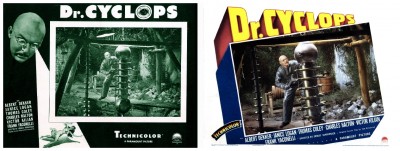 Doctor Cyclops would have been long-forgotten if not for Universal/MCA who, in 1958, purchased the television screening rights to more than seven hundred Paramount productions, which have been owned and controlled by Universal ever since. They immediately screened and repeated these films mercilessly, even prompting a comment in Roger Corman‘s film The Wasp Woman (1959), when a young woman complains that her boyfriend wants to stay at home that night to watch Doctor Cyclops: “Heck, I’ve seen that three times already!” And it’s with that thought in mind I’ll ask you to please join me next time when I will take you even closer to the event horizon of the insatiable black hole that is Hollywood for…Horror News! Toodles!
Doctor Cyclops would have been long-forgotten if not for Universal/MCA who, in 1958, purchased the television screening rights to more than seven hundred Paramount productions, which have been owned and controlled by Universal ever since. They immediately screened and repeated these films mercilessly, even prompting a comment in Roger Corman‘s film The Wasp Woman (1959), when a young woman complains that her boyfriend wants to stay at home that night to watch Doctor Cyclops: “Heck, I’ve seen that three times already!” And it’s with that thought in mind I’ll ask you to please join me next time when I will take you even closer to the event horizon of the insatiable black hole that is Hollywood for…Horror News! Toodles!
 Horror News | HNN Official Site | Horror Movies,Trailers, Reviews
Horror News | HNN Official Site | Horror Movies,Trailers, Reviews
